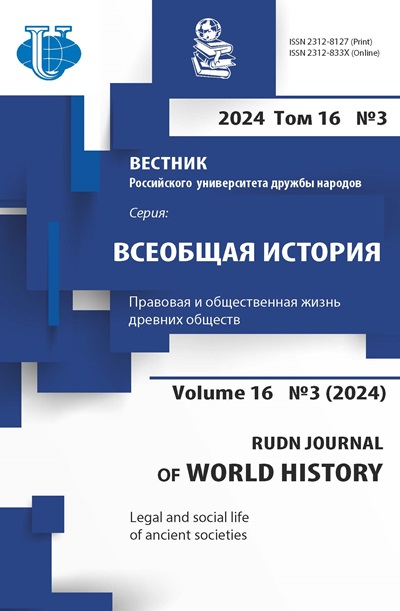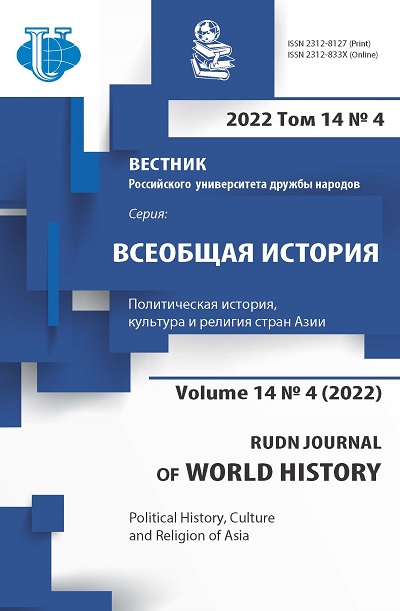Buddhism and Nationalism as Sources of Identity in in Asia of the Late 19th and Early 20th Centuries
- Authors: Kitinov B.U.1
-
Affiliations:
- Institute of Oriental Studies RAS
- Issue: Vol 14, No 4 (2022): Political History, Culture and Religion of Asia
- Pages: 355-372
- Section: Ideas and politics in history
- URL: https://journals.rudn.ru/world-history/article/view/33136
- DOI: https://doi.org/10.22363/2312-8127-2022-14-4-355-372
Cite item
Full Text
Abstract
The article examines the influence of Buddhism and nationalism on identification processes in Asian countries in the context of political transformations in the late 19th and early 20th centuries. Significant revitalization of Buddhism (sometimes called “Buddhist Modernism”) in a number of countries coincided with the growth of nationalism (especially in Russia, Mongolia, Tibet, China, and Japan), as well as the growing perception of Buddhist transnational unity. Nationalism and religion collaborated in their reactions to a number of important phenomena: the anti-colonial movement, the resistance against western cultural expansion (India, China, Japan), the aspiration of independence (Tibet, Mongolia), the renovation processes (in particular, among the Russian Buddhists). These phenomena were caused by objective factors, the changes in worldviews, as well as with activity of some individuals (Tagore, Tai-su, Uchida Ryohei, Dalai Lama, Agvan Dorjiev). The high level of civilizational depth allowed Buddhists of various traditions to assert their basic principles as important to identity resources.
Keywords
About the authors
Baatr U. Kitinov
Institute of Oriental Studies RAS
Author for correspondence.
Email: kitinov@mail.ru
ORCID iD: 0000-0003-4031-5667
Doctor Habilitatus, Associates Professor, Senior research fellow, Department of History of East
12 Rozhdestvenka St, Moscow, Russia, 107031References
- The Invention of Tradition, ed. by Е. Hobsbaum; Ranger, Terence. Cambridge University Press; 1983.
- Moore M. The Ethics of Nationalism. Oxford University Press; 2001.
- Kohn H. Western and Eastern nationalism, Nationalism. Ed. by John Hutchinson and Anthony D.Smith. Oxford University Press; 1994, р. 162–165.
- Norbu D. Culture and the Politics of Third World Nationalism. London: Routledge; 1992.
- Bechert H. Buddhismus, Staat und Gesellschaft in den Ländern des Theravaada-Buddhismus. Vol. 1, 2nd ed. Göttingen: Seminar für Indologie und Buddhismuskunde; 1988.
- Jaffe RM. Seeking Śākyamuni: Travel and the Reconstruction of Japanese Buddhism. Journal of Japanese Studies. 2004;30(1):65–96.
- Veer P. van der. Religious Nationalism. Hindus and Muslims in India. Berkeley: University of California Press; 1994.
- Hay SN. Asian Ideas of East and West — Tagore and His Critics in Japan, China and India. Harvard University Press; 1970.
- Rozenberg OO. Trudy po buddizmu [Works on Buddhism]. Moscow: Nauka publ.; 1991. (In Russ.)
- Mohan P. Ji Xianlin: The Tagore of China. India-China Relations. Civilizational Perspective. Ed. by Wang Shuying and B.R. Deepak. New Delhi: MANAK Publications PVT. LTD.; 2012, р. 263–277.
- Liu JA. Cultural Bridge between China and India. Rabindranath Tagore’s Visit to China Reconsidered. India-China Relations. Civilizational Perspective, ed. by W. Shuying, B.R. Deepak. New Delhi: MANAK Publications PVT. LTD.; 2012, р. 233–254.
- Kim H. “The Future of Korean Buddhism Lies in My Hands”: Takeda Hanshi as a Sōtō Missionary. Japanese Journal of Religious Studies. 2010;37(1):99–135.
- Sueki Fumihiko. Chinese Buddhism and the Anti-Japan War. Japanese Journal of Religious Studies. 2010;37(1):9–20.
- Abaev NV. O nekotorykh geopoliticheskikh predposylkakh razvitiia buddizma v Rossii i «Evraziyskaia khartiia» [On some geopolitical prerequisites for the development of Buddhism in Russia and “The Eurasian Charter”]. Znanie. Ponimanie. Umenie Available from: http://www.zpu-journal.ru/zpu/e-publications/2007/Abaev_NV/ [Accessed on 21.03.2018]. (In Russ.)
- Agreement between Great Britain, China on Tibet amending Trade Regulations in Tibet, of December 5, 1893. Signed at Calcutta, April 20, 1908. Available from: http://www. claudearpi.net/maintenance/uploaded_pics/1908ConventionbetweenGreatBritainC hinaonTibet.pdf [Accessed on 25.06.2014]
- Rossiĭa i Tibet: sbornik russkikh arkhivnykh dokumentov, 1900–1914 [Russia and Tibet: a collection of Russian archival documents, 1900–1914]. Moscow: Eastern literature publishing house; 2005. (In Russ.)
- Andreev A.I. Tibet v politike tsarskoĭ, sovetskoĭ i postsovetskoĭ Rossii [Tibet in the politics of Tsarist, Soviet and post-Soviet Russia]. St. Petersburg: Publishing House of St. Petersburg University, Publishing House of Narthang; 2006. (In Russ.)
- Shakabpa V.D. Zepon. Tibet. Politicheskaia istoriia [Tibet. The political history] St. Petersburg: Publishing House of Narthang; 2003. (In Russ.)
- Treaties, etc. between Great Britain and China, and between China and foreign powers, and orders in Council, rules, regulations, acts of Parliament, decrees, etc, affecting British interests in China. Vol. 1. London: Harrison and sons; 1908.
- Spengen Wim van. Tibetan Border Worlds: Geohistorical Analysis of Trade and Traders. London and New York: Kegan Paul International; 2000.
- Elverskog J. Our Great Qing. The Mongols, Buddhism and the State in Late Imperial China. Univ. of Hawai’i Press; 2006.
- King Matthew W. Ocean of Milk, Ocean of Blood. A Mongolian monk in the ruins of the Qing empire. Columbia University Press; 2019.
- Zhitetskiĭ I. Astrakhanskie kalmyki (Nabliudeniia i zametki) [The Astrakhan Kalmyks (Observations and Notes)]. Astrakhan; 1892. (In Russ.)
- Gerasimova K.M. Obnovlencheskoe dvizhenie buryatskogo lamaistskogo dukhovenstva: 1917–1930 gg. [Renovationist movement of the Buryat Lamaist clergy: 1917–1930]. UlanUde: Buryat book publishing house; 1964. (In Russ.)
- Ukhtomskiĭ E.E. Ot Kalmytskoĭ stepi — do Bukhary [From the Kalmyk steppe — to Bukhara]. St. Petersburg: The Printing House of Prince V.P. Meshchersky; 1891. (In Russ.)
- National Archive of the Republic of Kalmykia. F. P-145. List 1. File 217; F. B-90. List 2. File 77. (In Russ.)
- Berzin Alexander Prinyatie posviashcheniia Kalachakry [Taking the Kalachakra Initiation]. St. Petersburg: Publishing House of Narthang; 2002. (In Russ.)
- Russian State Historical Archive. F. 821. List 133. Files 446, 448, 395. (In Russ.)
- Shcherbatskoĭ F.I. Kratkiĭ otchet o poezdke v Urgu [A brief report on the trip to Urga], East — West. Research, translations, publications. Moscow: Publishing House of Vostochnaya literature; 1989, р. 250–253. (In Russ.)
- Tsyrempilov N.V. Buddizm i imperiia. Buryatskaia buddiĭskaia obshchina v Rossii (XVIII — nachalo XX v.) [Buddhism and Empire. Buryat Buddhist community in Russia (XVIII — early XX centuries)]. Ulan-Ude: Publishing House of IMBT SB RAS; 2013. (In Russ.)
- Archive of Foreign Policy of the Russian Empire. F. Chinese Table. List 491. File 1467. Years 1904–1906; File 1468. Year 1906; File 575. (In Russ.)
- Ngag dbang blo bzang rgya mtsho. Rgyal dbang lnga pa ngag dbang blo bzang rgya mtsho’i rnam thar du ku la’i gos bzang. Vol. 1. Lhasa: Bod ljongs mi dmangs dpe skrun khang; 2012. (In Tib.)
- Borisenko I. Khramy Kalmykii [Temples of Kalmykia]. Elista: Kalmyk book publishing house, 1994. (In Russ.)
- Smirnov Parmen. Putevye zapiski po Kalmytskim stepiam Astrakhanskoĭ gubernii [Travel notes on the Kalmyk steppes of the Astrakhan province]. Elista: Kalmyk book publishing house, 1999. (In Russ.)
- Pozdneev AM. Ocherki byta buddiĭskikh monastyreĭ i buddiyskogo dukhovenstva v Mongolii v sviazi s otnosheniem sego poslednego k narodu [Essays on the life of the Buddhist monasteries and the Buddhist clergy in Mongolia in connection with the attitude of the latter to the people]. Elista: Kalmyk book publishing house; 1993. (In Russ.)
- Danilin AG. Burkhanizm [Burkhanism]. Gorno-Altaisk: Publishing House of Ak Chechek; 1993. (In Russ.)
- Mongush MV. Istoriia buddizma v Tuve (pervaia polovina VI — konets XX v.) [The history of Buddhism in Tuva (first half of 6th — end of 20th century)]. Novosibirsk: Nauka publ.; 2001. (In Russ.)
- Yerasov B.S. Tsivilizatsii. Universalii i samobytnost’ [Civilizations. Universals and Originality]. Moscow: Nauka publ.; 2002. (In Russ.)













